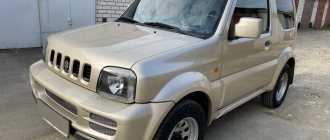Our first Vesta Cross test can answer the question of whether you need to overpay 43 thousand rubles for a Cross or stick with the quiet, universal Vesta. Cross seems to be shouting, take me, he tried his best to prove that he was right and even climbed the almost vertical wall of the Sochi forest. Video Vesta Cross test, about how we, blasting stones, took mountain heights below, technical characteristics at the end of the article.
Please vote by studying our Vesta Cross test by moving the MPS Index cursor along the scale that we offer at the beginning and end of the article.
I won’t list all the station wagons I’ve owned, starting with the VAZ 2102; my evolution today has stopped at the sloping rear door of the Audi A7. Surprisingly, it seems that in pursuit of the tastes of buyers like me, Lada in its new station wagon moved away from the almost vertical rear wall. True, the slope of the rear window was not so strong that, as in my Sportback, I would have to abandon the wiper, but it was sufficient for the roofline to acquire the now fashionable dynamics.
Lada-Vesta-SW and Lada-Vesta-SW Cross: Let’s imagine for a moment another VAZ-2104 next to it. It seems to me that it will stand here like an ancient stone. What kind of dynamic roof line were they thinking about then, I loaded the refrigerator into the dacha. And the universal Vesta even has a “shark fin” on the roof - it’s also an external antenna. This is what competition for me, my beloved, means.
According to Lada designer Steve Mattin, “the roof line, starting from the exterior mirrors, and the “shark fin” form a kind of airy, elegant X.” It turns out that there are never too many X's on a clean car. If it weren't for the X's, I would have thought it was a Volvo. The dual chrome exhaust tips are modern, and there's room on the right for two more fake pipes.
Lada-Vesta-SW and Lada-Vesta-SW-Cross: produced in Izhevsk. The basic station wagon (right) looks simpler. It does not have two-tone bumpers or plastic linings surrounding the body; it is 4 mm shorter and 25 mm lower than the Cross.
Prices for Lada-Vesta-SW start from 639,900 rubles, in the Cross base it is 116 thousand more expensive. But at the top, in the most expensive configuration, the difference is only 43 thousand (1.8 l, 16 cl, 122 hp, 5 AMT). The difference of 43 thousand can be found in the middle of the price list (1.8, 16 cl., 122 hp, 5 MT).
Our first Vesta Cross test took place in Sochi, where we drove through the forest and along steep hills. The Cross sports more aggressive bumpers with black and silver linings, and, of course, a body kit around the perimeter of the entire body. It seems like a sham, but with frequent driving on unpaved and simply dirty roads, the overlays should extend the life of the paint on the sills and wheel arches. And this is a question of corrosion resistance and presentation of station wagons after several years of intensive use. But owners of simple station wagons can save money in the event of a rear-end collision - their bumper is completely borrowed from the sedan. But Cross’s bumpers are original and quite complexly organized.
For the Lada Vesta, the cross in the forest is somehow calmer, the plastic body protects.
Is it possible to load the refrigerator?
The stated trunk volume is 480 liters. It seems not bad at all, but when you lift the back door, you find a clearly smaller hold; not every refrigerator will fit. However, the floor panels are liftable, and underneath them hides a pair of organizers with a total volume of 95 liters. For convenience, the trunk can be divided into 2 parts, and plastic organizers can be completely removed.
On the left is a place for storing containers with a fixing strap, a 15-liter niche in the area of the right wheel arch, covered with a lid.
With the second row seats folded – 825 liters. The double floor with organizer aims to create a flat surface when folding the rear seatbacks, but, as we can see, it doesn’t work very well. The rear seat cushion will not stand upright; it must be removed from the passenger compartment to level the floor; you can remove it, but this is not an easy task.
Under the main floor, of course, there is a full-size spare wheel, although it is 15-inch and on a steel rim. Next to the spare tire is another organizer and a thick layer of sound insulation. On the sides of the trunk there are also compartments for small items, hooks for packages and even a 12-volt outlet. Unexpected luxury for a budget car. The fifth door is closed with powerful handles, which are provided both on the right and on the left.
We sit in the back.
Lada-Vesta-SW
Lada-Vesta-SW-Cross: Here the head does not rest against the ceiling, and there is enough legroom in a regular Vesta. Unlike the sedan, the distance from the seat to the ceiling has increased by 25 mm. Reach forward and you will find heated rear seats.
With the new rear doors, getting into the back seat has become more convenient. A central armrest with a pair of cup holders has appeared, and in the maximum version, for those sitting in the back, there is a heated rear sofa, a USB connector and a 12-volt socket. But the headrests are not very comfortable - in the upper position they are too low for people 180 cm tall and above.
Available configurations
If you go to the official website lada.ru, you will see that the most affordable configuration of the Vesta SV Cross, on which you can install a robotic box, is Luxe with the assigned code GFK32-52-X00. Its cost is 845,900 rubles. A machine of this configuration is equipped with almost everything necessary, is very comfortable and safe.
The next model configuration is called Luxe Multimedia with code GFK32-52-XK2. The price tag for it is higher than the previous one and equals 873,900 rubles. As is clear from the name of the configuration, the difference between it lies in multimedia. The more expensive trim level is equipped with a navigation system and six speakers, while the poorer trim level has “only” four speakers.
The last, most expensive trim level is Luxe Prestige. Code designation GFK32-52-XSH. It differs from the “multimedia” version in the presence of a rear armrest, tinted rear windows, a power outlet in the rear and heated rear seats. For the “fattest” configuration you have to pay 891,900 rubles.
To confirm our words about the cost of a robotic box, we offer you a few simple steps. Pay attention to the Luxe Multimedia package, but with a manual transmission.
As you can see in the picture, the cost of a model with this equipment is 823,900, which is exactly 25,000 cheaper than with AMT. Simple math in action.
Let's get behind the wheel.
The interior of the Vesta station wagon differs little from the Vesta sedan. But the Lada Cross is painted from the heart.
Lada-Vesta-SW
Lada-Vesta-SW-Cross
Over the past 2 years, VAZ has not only managed to develop a station wagon, but also slightly modified the interior. In the top versions, a full-fledged central armrest finally appeared. It is convenient to place your right hand on it, and there is a small compartment inside. In order to cheer up the driver, Vesta SW and Vesta Cross received a painted instrument panel.
Tolyatti residents clearly picked up this idea from Renault Stepway; it also has orange accents in the interior.
The simple station wagon has only slightly colored instruments, while the raised version has the Cross inscription on the speedometer and brighter accents. In addition, it is distinguished by contrasting inserts on the seats, a different pattern on the plastic inserts of the front panel and doors, as well as chrome handles. The handles on the station wagon are matte.
The difference between SW Cross and regular Vesta
The SV Cross differs from the basic station wagon by the presence of a plastic body kit and wheels with a diameter of 17 inches. The ground clearance has been increased to 20.3 cm (instead of the standard 17.8 cm). The new Lada has already been compared to the Renault Duster crossover. The domestic car is superior to the French “competitor” in terms of length and even ground clearance.
The developers also improved the already good suspension from the regular Vesta, shock absorbers and springs were replaced. This has led to the fact that the Vesta Sw Cross 2022 holds the road and handles even better than the Lada without the “Cross” prefix.
Exterior
The rear door opening has increased, and the window frame has also “raised.” The roof slope has become flatter. This makes the position of passengers in the rear seat more comfortable, because There is enough space between their heads and the ceilings.
The inclination of the rear pillars is the same as on all bodies with a shortened rear overhang - slightly forward. The fifth door connector resembles a shark fin and runs along the top of the pillars.
The body of the 2022 Lada Vesta SV Cross is 15 cm higher than the classic sedan, and slightly wider thanks to the wheel arches. The new Lada is equipped with rear disc brakes. But this update is only for “advanced” versions.
The fuel filler flap now has a central lock, with which it is locked and latched. The protruding “ear” has been removed. The modernization also affected the trunk lock: now it opens and closes using a button. It is located under the license plate.
The design of the antenna has changed: instead of a twig that will remain on the sedan, it finally took the shape of an elegant fin. The exhaust pipe is equipped with a double-barreled nozzle (the base model does not have this upgrade).
The color scheme of the 2022 Lada Vesta SV Cross includes 10 shades. All of them are bright and juicy, which gives the car even more charisma. Each, according to AvtoVAZ tradition, has its own name - “Mars”, “Glacial”, “Black Pearl”. This is a “stretch” of monochrome colors - from pearly white to elegant black, as well as orange and red shades.
Interior
In front, between the seats, there is a box armrest. And the rear sofa is equipped with a folding armrest. The instrument scale has a stylish design.
Inside, the upholstery of the Lada Vesta SW Cross 2022 is made in the same colors as the exterior trim. For example, the shade “mars” is a metallic orange color. Inside the cabin, the standard dark graphite paint on the seats is combined with orange stripes and dark gray accents. The inner sides of the doors and the control panel are decorated in the same style.
The steering wheel comes complete with control units and a massive suspension. The design of the instrument console in the form of three “wells” is just like on sports cars. The central panel has a small display and control units.
The back seat of the Lada Vesta SV Cross 2022 is a three-seater sofa. It is separate, the backrests fold. Wear-resistant materials or textiles are used as finishing. Leather is not used.
Luggage compartment:
Technical stuffing
The Lada Vesta SW Cross 2022 crossover with a new body is equipped with a new 1.8 liter engine. Also, the basic configuration includes VAZ gasoline engines with 16 valves.
The official website presents 2 versions of the engine with a power of 106 l/s (at 5800 rpm) and 122 l/s (at 5900 rpm).
1.6 106 hp; 1.8 122 hp
The 1.8 engine has an index of 21179. It has already been installed on the Lada Vesta sedan produced in 2016. It had disadvantages - knocking hydraulic compensators and too high fuel consumption. But in the new revised version these shortcomings have been eliminated.
The classic automated gearbox is not installed in this version of the Lada. The developers explained their decision by saying that otherwise the cost of the car would have been much higher.
A manual transmission will be installed for the 1.6 liter engine, and a mechanical and robotic one for the 1.8 engine.
The sills and bottom of the 2022 Lada Vesta SV Cross are equipped with anti-gravel protection. The material used for the outer body panels is double galvanized steel.
The safety system includes front and side airbags, head restraints in the rear seats, child seat mounts, automatic door unlocking and activation of the emergency signal in the event of a collision, automatic locking when starting to move on the road, activation of the hazard warning lights during sudden braking, ABS and ESP complexes , light and rain sensors, anti-theft protection, cruise control and ERA-GLONASS, all this puts the new body of the 2022 model year Lada Vesta SW Cross on the same level as competitors from a foreign manufacturer.
Motor
Lada-Vesta-SW: 1.8-liter, 122-horsepower, 16-valve.
But the 1.8-liter 122-horsepower engine disappointed. Even paired with mechanics borrowed from Renault, the engine clearly does not live up to expectations. We drove the Vesta together, and when accelerating to the floor, the acceleration in higher gears occurs slowly. Perhaps the problem is that the test cars have not yet been run-in, and the odometers only have 500-600 km. However, Korean classmates, already leaving the factory, drive better even with a more modest volume of 1.6 liters. Compared to them, the VAZ engine trembles under load and even after 2000 rpm does not indulge in traction reserves. Yes, Tolyatti units have proven themselves to be very reliable and repairable, but in the modern world this is no longer enough. They clearly need to improve traction both at low and high speeds.
Lada-Vesta-SW-Cross, like its station wagon brother, is equipped with two engines - 1.6 (106 hp) and 1.8 liters (122 hp).
Disadvantages of the 2022 Lada West SV Cross in a new body
Engine
The engine of the Lada Vesta is a modification of the 16-valve Priora engine. For some, it rattles when not warmed up or at idle or whistles. Whistling is generally typical for such a motor, so you can simply ignore it.
The weak link of such engines remains the electrics: some complain about the electronic gas pedal, starts on the 2-3rd attempt even when it’s warm, and unstable idle. A Vesta with a Euro-5 engine needs only high-quality gasoline; left-handed gasoline can cause hang-ups and bent valves.
The new 1.8 engine for Vesta can please you with increased oil consumption at the beginning of movement. There is a theory that the cause may be poorly processed valve stems made in China, which AvtoVAZ quickly replaced with others, thus eliminating the problem.
Transmission
Not everything is so rosy for Vesta with gearboxes. The mechanics are characterized by weak synchronizers, this is especially noticeable in second gear, therefore, with increasing service life, it begins to resist when switched on, and in cold weather it can turn on even worse.
However, since October 2016, AvtoVAZ began installing more “heat-resistant” clutches on Vesta, so this is a problem with the first generations of the car.
Sometimes there are problems with installing autostart: there have been cases when a car with robots started moving in remote start mode. The robot can safely be called Vesta’s weak link. It often makes the driver nervous: slow operation and failures in traction during acceleration can make anyone nervous, although starting from a standstill seems to be set up well.
Chassis
Another source of intrusive knocks and clunks when driving is the suspension. This problem is systemic. Creaks when crossing speed bumps appear due to a strong twist of the stabilizer joints, about which the manufacturer, with a certain amount of cunning, stated that this was supposedly the fault of the brutal Russian roads.
Let's go for a ride again.
On the road, the Vesta station wagon is practically no different from the sedan. The body turned out to be very rigid and the car follows the wheel perfectly. The steering wheel with a standard electric booster is an example of accuracy and information content. Vesta Cross is 25 mm higher (station wagon ground clearance 178 mm) and this had its effect. While you're driving quietly, the difference is almost imperceptible, but on the shifts you feel a little deeper body roll, which stems not only from the high suspension, but also from the wider and grippier Pirelli tires.
On crossovers, the Cross rolls a little more than a station wagon.
Lada-Vesta-SW-Cross
And when leaving the asphalt, it is better to slow down a little. Low-profile 17-inch wheels do not favor sharp bumps too much, and, secondly, the increase in ground clearance has led to a reduction in the rebound stroke. At bends in the road, the wheels continually end up in the air.
When hanging one wheel, the trunk opens easily, which indicates sufficient body rigidity.
If you lock the car in this position, the trunk opens perfectly, which is great. However, from the point of view of cross-country ability, the reduction in the rebound stroke is a definite disadvantage. So, if the needs for increased ground clearance are not too great, try to get by with the regular Vesta station wagon or think about switching to more modest rims; perhaps off-road tires would be better suited. But this is a topic for a separate conversation, when the time comes for the all-wheel drive Vesta.
Will there be all-wheel drive?
Lada-Vesta-SW-Cross
When asked directly about the release date of the Vesta Cross with all-wheel drive, the VAZ team is evasive in Russian. They say that the market is unlikely to be ready to buy such a car in large volumes, and as long as there is no confirmed demand, there is no production. But considering that the rear beam on the Vesta is very similar to that of the Lada Largus, and therefore the Renault Duster, technically there is certainly such a possibility. All that remains is to attach the box not from Logan, but from the all-wheel drive Duster, to the VAZ engine, select the appropriate length of the cardan shafts and adjust the clutch in the rear wheel drive. But considering that the construction of the station wagon took the Togliatti residents 2 years instead of the promised one, the all-wheel drive Vesta will have to wait in the hope that it will remain in the fashion trend.
So what should you choose?
For those who want a truly large trunk, it is definitely better to look at the larger Lada Largus; it will carry almost twice as much luggage, and it will also be more convenient for passengers. But in essence, Largus is a big first-generation Logan, with all that it implies. Vesta is the choice of a driver who wants, first of all, to get a stylish and dynamic car, and a beautifully finished trunk and increased ground clearance are a pleasant bonus that sets Vesta Cross apart from the line of ordinary sedans. Well, in general, we got the hint.
Let’s also add that Vesta Cross is a good signal that Lada... (ugh, ugh, ugh) can.
From the author of the blog automps.ru Peter Menshikh: I thank Igor Sirin (co-author and presenter of the video), Evgeniy Mikhalkevich (cameraman, photographer) for participating in the preparation of the Vesta Cross test.
Vesta Cross test video below, technical specifications at the end.
Subjective disadvantages and disadvantages of Lada Vesta Cross 2022 - 2018
The most serious drawback is the robot box, which is currently being installed on the assembly line and which migrated here from Priora. Yes, AvtoVAZ said that they completely redesigned it and tuned it.
But in fact, everything remained unchanged. Both on Priora and on Vesta. The robot also delays with switching, it can freeze, it can switch too early, so that the car nods. I read a lot on forums that the robot is adaptive and over time adapts to the driver’s driving style. But this didn’t happen to me. IMHO, mechanics, in this case, is the most preferable option.
The second disadvantage of the Lada Vesta SV Cross is that the suspension is very noisy. Now I’m not talking about specific breakdowns, when you change something and the noise disappears. It's all about the work itself. Even a fully operational car that rolls off the production line immediately starts to become noisy when entering the highway. Yes, if you moved from nine, you will feel progress and quiet operation of the suspension. And if you moved from the same Kia Rio or Solaris, which are Vesta’s classmates, you will undoubtedly understand that Vesta is much noisier.
The third subjective drawback of the Lada Vesta SV Cross is poor sound insulation. In the cabin you can hear the noise of the wheels, all the joints and unevenness of the road very well. And also a lot of crickets. Many Vesta sedan and station wagon owners simply coat the car with sound insulation immediately after purchase.
Next we move on to ergonomics. As for me, the controls for the power windows and heated seats are not very conveniently located. The power windows do not have an automatic mode. The seat belts are not located quite correctly, which is why it is not as convenient to fasten as in most foreign cars. Although over time you get used to it. If the steering wheel is made of imitation leather, it is not very comfortable, since in the heat your hands sweat and it becomes slippery.
LADA VESTA SW — LADA VESTA SW CROSS
Specifications
| COMMON DATA | Lada Vesta SW 1.8 5MT (5AMT) | Lada Vesta SW 1.6 5MT (5AMT) | Lada Vesta SW Cross 1.8 5MT (5AMT) | Lada Vesta SW Cross 1.6 5MT |
| Dimensions, mm: length / width / height / base | 4410 / 1764 / 1512 / 2635 | 4410 / 1764 / 1512 / 2635 | 4424 / 1785 / 1532 / 2635 | 4424 / 1785 / 1532 / 2635 |
| front/rear track | 1510 / 1510 | 1510 / 1510 | 1510 / 1510 | 1524 / 1524 |
| Trunk volume, l | 480 / 825 | 480 / 825 | 480 / 825 | 480 / 825 |
| Ground clearance, mm | 178 | 178 | 203 | 203 |
| Curb weight, kg | 1330 | 1280 | 1350 | 1300 |
| Acceleration time 0 - 100 km/h, s | 10,9 (12,9) | 12,4 (14,4) | 11,2 (13,3) | 12,6 |
| Maximum speed, km/h | 180 (182) | 174 (174) | 180 (181) | 172 |
| Fuel / fuel reserve, l | A92/55 | A92/55 | A92/55 | A92/55 |
| Fuel consumption: urban/suburban/combined cycle, l/100 km | 10,6 / 6,3 / 7,8 (9,9 / 6,2 / 7,6) | 9,5 / 5,9 / 7,3 (9,2 / 5,7 / 7,0) | 10,7 / 6,4 / 7,9 (10,1 / 6,3 / 7,7) | 9,7 / 6,0 / 7,5 |
| ENGINE | ||||
| Location | Front transverse | Front transverse | Front transverse | Front transverse |
| Configuration / number of valves | P4/16 | P4/16 | P4/16 | P4/16 |
| Working volume, cubic meters cm | 1774 | 1596 | 1774 | 1596 |
| Power, kW/hp | 90 / 122 at 5900 rpm. | 78 / 106 at 5800 rpm. | 90 / 122 at 5900 rpm. | 78 / 106 at 5800 rpm. |
| Torque, Nm | 170 at 3700 rpm. | 148 at 4200 rpm. | 170 at 3700 rpm. | 148 at 4200 rpm. |
| TRANSMISSION | ||||
| Type | front-wheel drive | front-wheel drive | front-wheel drive | front-wheel drive |
| Transmission | M5 (P5) | M5 (P5) | M5 (P5) | M5 |
| CHASSIS | ||||
| Suspension: front/rear | McPherson / elastic beam | McPherson / elastic beam | McPherson / elastic beam | McPherson / elastic beam |
| Steering | rack and pinion with electric booster | rack and pinion with electric booster | rack and pinion with electric booster | rack and pinion with electric booster |
| Brakes: front / rear | disk / disk | disc / drum | disk / disk | disc / drum |
| Tire size | 185/65R15 or 195/55R16 | 185/65R15 or 195/55R16 | 205/50R17 | 205/50R17 |
Gear ratio AMT Lada Vesta SV Cross
However, it is not entirely fair to consider the robot installed on Grant, Kalina and Priora to be similar to Vesta’s robot. The fact is that in the new model, AvtoVAZ engineers have significantly improved the settings of the gearbox itself. Yes, there are no fundamental changes, but there are still minor differences. For example, the difference in gear ratio. On AMT SV Cross it is 3.9, for the rest - 3.7.
During practical tests, it was found that when the speed reached 120 km/h, Vesta’s tachometer showed 3200 rpm, while on “old” models the same indicator froze at around 3000 rpm.











